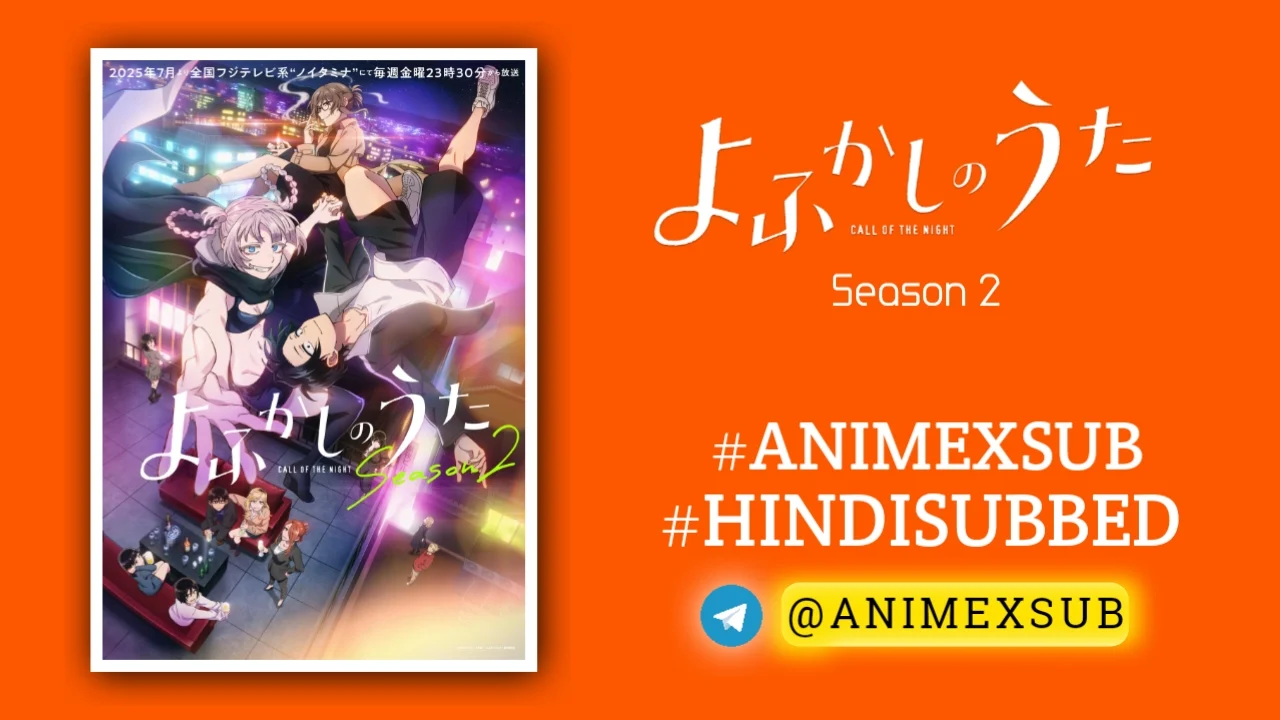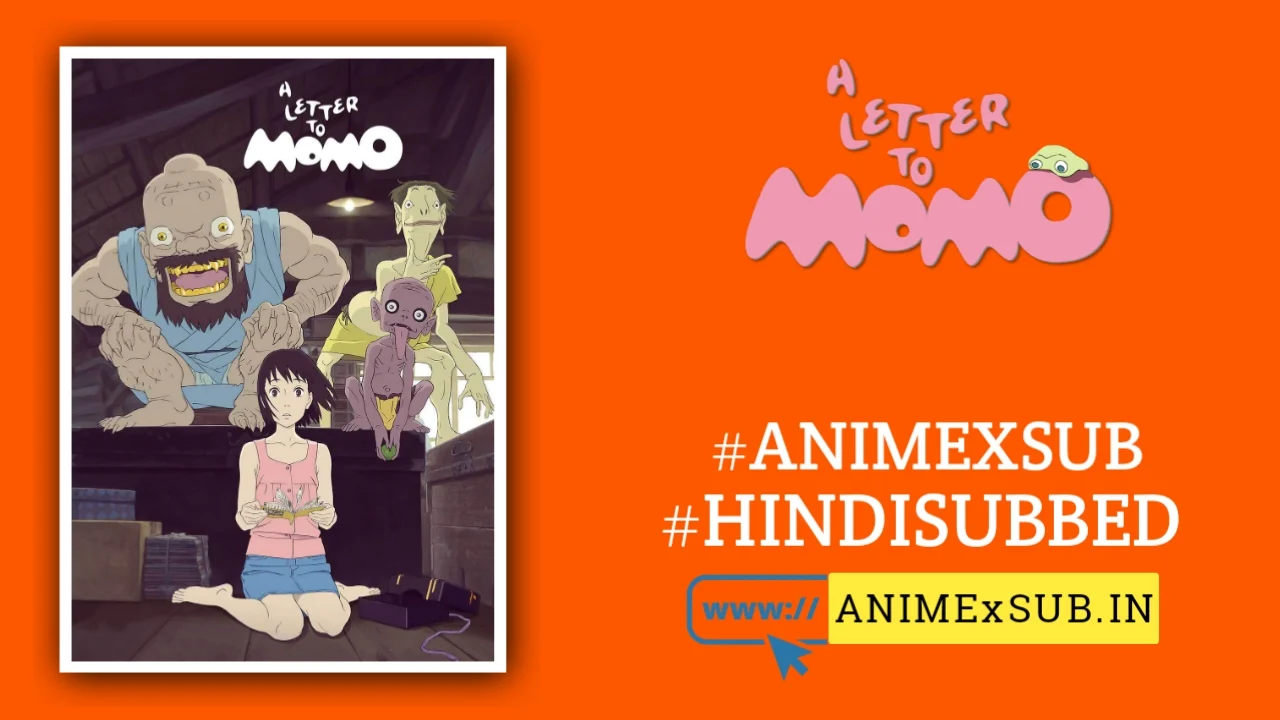
Call of the Night Season 2 Hindi Subbed [11/12] | Yofukashi no Uta 2 Hindi Sub

Yofukashi no Uta Season 2
Call of the Night Season 2Synopsis
The second season of Yofukashi no Uta. Ko overcomes his confusion about becoming a vampire and decides to "like" Nazuna, while Nazuna resolves to make Ko "fall in love" with her. Without understanding what "love" even is, the two of them spend their nights together in a frenzy. Meanwhile, Detective Uguisu Anko is closing in with her plot to kill vampires, not just Nazuna. A vampire's weakness is "anything they were attached to when they were human" and so they all try to get rid of this weakness before it's too late. But, Nazuna has no memory of her human life. What is Nazuna's hidden past? Why did Anko start killing vampires? And what is the "secret" that Nazuna and Anko share? For Ko, Nazuna, Anko, a fun "late night" doesn't end here... a new "night" begins! (Source: HIDIVE)
Watch Trailer
Characters
Episodes
How To Download Tutorial
Call of the Night Season 2: Nocturnal Evolution in a World of Eternal Twilight
Introduction: Answering the Siren’s Call After Three Years
Call of the Night, or Yofukashi no Uta in its original Japanese, has always thrived in the liminal spaces between day and night, blending supernatural allure with introspective romance. Premiering its second season on July 4, 2025, after a three-year hiatus since the 2022 debut, the series returns under LIDENFILMS with director Tomoyuki Itamura at the helm. This 12-episode run, airing weekly on Fuji TV’s Noitamina block and simulcast on HIDIVE and Crunchyroll, picks up seamlessly from Ko Yamori’s unresolved quest to become a vampire through his bond with Nazuna Nanakusa. What unfolds is not just a continuation but a deeper plunge into the psychological undercurrents of immortality, identity, and the intoxicating freedom of the nocturnal realm. As of mid-September 2025, with episode 11 recently aired, the season has solidified its reputation as a masterclass in atmospheric storytelling, surpassing expectations by weaving fresh lore into its signature vibe-driven narrative.
Plot Deep Dive: From Midnight Wanderings to Shadowed Legacies
Season 2 catapults Ko and Nazuna into the “Cigarette Case Arc,” a pivotal adaptation from Kotoyama’s manga (which concluded in 2024 after 20 volumes). Ko, the insomniac high schooler who ditched daytime drudgery for endless nights, now grapples with the vampire world’s rigid hierarchies. To turn him, Nazuna must genuinely fall in love—a condition that exposes her fragmented past as a human-vampire hybrid. Enter Haru Nanakusa, voiced by Maaya Uchida, a enigmatic nurse who holds the key to Nazuna’s amnesia-ridden origins. This arc introduces Kiku Hoshimi (Rina Sato), a formidable vampire enforcer, escalating tensions with vampire society that views Ko as an illicit “snack” for Nazuna.
Unlike season 1’s meandering slice-of-life explorations of urban nightlife, this installment ramps up intrigue. Episodes 1-4 rekindle the duo’s playful flights over Tokyo’s neon sprawl, but by episode 5, confrontations with rival vampires like the returning Niko, Seri, and newcomer antagonists reveal the perils of hybrid existence. A standout mid-season twist in episode 8 unveils Nazuna’s pre-vampire life through hallucinatory flashbacks, blending horror-tinged mystery with poignant reflections on lost humanity. Recent episodes, including the cliffhanger-heavy 10 and the emotionally charged 11, focus on alliances forming against a shadowy vampire council, forcing Ko to confront whether eternal night means eternal isolation. The narrative’s uniqueness lies in its subversion: vampires aren’t glamorous predators but flawed misfits navigating bureaucracy and boredom, mirroring modern existential dread in a fantastical shell.
Character Arcs: Beyond Bloodlust, Into the Heart of the Night
Ko Yamori’s evolution is the season’s emotional core. No longer the wide-eyed teen from season 1, his arc delves into the nuances of unrequited affection and self-discovery. Episodes showcase his internal monologues—eloquently scripted by Michiko Yokote—questioning if love is a prerequisite for transformation or a trap of vulnerability. Gen Sato’s voice work captures Ko’s shift from passive observer to active participant, especially in tense standoffs where he leverages human ingenuity against supernatural foes.
Nazuna Nanakusa remains the chaotic heartbeat, her carefree demeanor cracking to reveal buried trauma. Sora Amamiya’s performance layers whimsy with subtle heartbreak, particularly in scenes probing her hybrid identity. New additions like Haru add depth: as Nazuna’s long-lost sister figure, she embodies the “what if” of a normal life, challenging the duo’s nocturnal escapism. Supporting vampires, from the boisterous Midori to the stoic Hatsuka, receive expanded backstories, humanizing the ensemble. A fresh dynamic emerges in episode 11’s resolution of a key betrayal, where characters like Kiku evolve from antagonists to uneasy allies, highlighting themes of found family amid immortal solitude. This season’s character work feels profoundly intimate, using quiet night walks as metaphors for emotional intimacy, a step beyond season 1’s surface-level charm.
Animation and Sound: A Symphony of Shadows and Silence
LIDENFILMS elevates the visual poetry that defined the original. Nighttime Tokyo is rendered with hyper-detailed backgrounds—rain-slicked alleys glowing under flickering signs, starlit rooftops alive with subtle animations of wind and distant traffic. Character designs by Haruka Sagawa retain their fluid expressiveness, but action sequences in episodes 6 and 10 introduce dynamic flourishes: fluid vampire flights with particle effects mimicking moonlight refraction, and fight scenes employing innovative lighting inspired by noir cinema, like the subtle lens flares evoking Max Payne 3 aesthetics noted by fans. The animation budget shines in hallucinatory sequences, where reality blurs into dreamlike distortions, a technical leap that outpaces many 2025 contemporaries.
Yoshiaki Dewa’s score masterfully balances tension and tranquility. Creepy Nuts return with OP “Mirage” and ED “Nemure,” their hip-hop-infused tracks syncing perfectly with stylish sequences that intercut serene flights with foreshadowed battles. Ambient sound design—distant city hums, echoing footsteps, the soft whoosh of wings—immerses viewers in the night’s sensory tapestry, making silence as potent as any crescendo. Subtle inserts like “Loss Time” underscore emotional beats, creating an auditory nocturne that lingers long after credits roll.
Thematic Resonance: Immortality’s Double-Edged Moonlight
At its essence, season 2 interrogates the allure of escapism in a hyper-connected world. Ko’s rejection of daylight society parallels Gen Z’s disillusionment with routine, while Nazuna’s hybrid plight explores cultural alienation—vampires as eternal outsiders in their own realm. The series uniquely frames love not as fairy-tale romance but a pragmatic hurdle to transcendence, prompting viewers to ponder: Is eternal youth worth forsaking human connections? Deeper still, it critiques immortality’s stagnation; vampires hoard memories like relics, contrasting Ko’s fresh perspective. This philosophical underlayer, woven through dialogue-heavy episodes, elevates the show beyond genre tropes, offering a meditative lens on mental health—insomnia as metaphor for unfulfilled longing—and the blurred lines between freedom and loneliness. In 2025’s anime landscape, amid high-octane shonen, this quiet profundity feels revolutionary.
Fan and Critical Echoes: A Resonant Return
Reception has been overwhelmingly positive, with MyAnimeList scores hovering around 8.5/10 for early episodes, praising the seamless hiatus bridge. Reddit discussions highlight the “peak vibes” recapture, though some lament the lack of reintroductions for lapsed viewers. 23 IMDb users applaud the mature scripting and psychological depth, calling it “breathtaking” for its art and character growth. 24 First impressions from sites like Beneath the Tangles note the effortless atmosphere but critique minor continuity jumps. 21 On X, fans buzz about episode 11’s heartfelt moments and animation highs, with posts sharing screenshots of tender Ko-Nazuna interactions. 5 Expectations for the finale center on resolving the council threat, with many hailing it as 2025’s most underrated gem.
Conclusion: The Night’s Unfinished Symphony
Call of the Night Season 2 doesn’t just extend its predecessor’s legacy; it redefines it, transforming a vibe-centric romance into a layered exploration of eternal twilight. By September 13, 2025, with the finale looming, it stands as a testament to anime’s power to capture the ineffable pull of the dark hours—informative in its lore, unique in its introspection, and profoundly moving. For night owls seeking substance amid spectacle, this season is an indispensable descent into the shadows.1






















